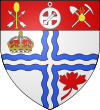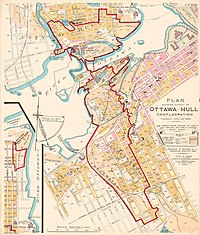
Ottawa is the capital city of Canada. It is located in Eastern Ontario, at the confluence of the Ottawa River and the Rideau River. Ottawa borders Gatineau, Quebec, and forms the core of the Ottawa–Gatineau census metropolitan area (CMA) and the National Capital Region (NCR). As of 2021, Ottawa had a city population of 1,017,449 and a metropolitan population of 1,488,307, making it the fourth-largest city and fourth-largest metropolitan area in Canada.

Gatineau is a city in south western Quebec, Canada. It is located on the northern bank of the Gatineau river, immediately across from Ottawa, Ontario. Gatineau is the largest city in the Outaouais administrative region and is part of Canada's National Capital Region. As of 2021, Gatineau is the fourth-largest city in Quebec with a population of 291,041, and a census metropolitan area population of 1,488,307 making it the fourth largest in Canada.
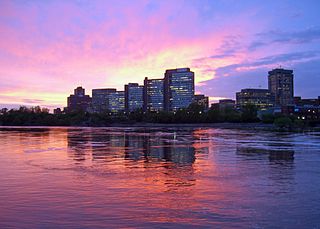
Hull is the central business district and oldest neighbourhood of the city of Gatineau, Quebec, Canada. It is located on the west bank of the Gatineau River and the north shore of the Ottawa River, directly opposite Ottawa. As part of the Canadian National Capital Region, it contains offices for over 20,000 civil servants. It is named after Kingston upon Hull in England.

Buckingham is a former town located in the Outaouais region in the western portion of the province of Quebec, Canada. Since 1 January 2002, it has been part of the amalgamated city of Gatineau, which merged five former municipalities, including Masson-Angers, Buckingham, Hull, Aylmer and Gatineau, into a single entity. According to the 2016 Census, the population of the town was 16,685.
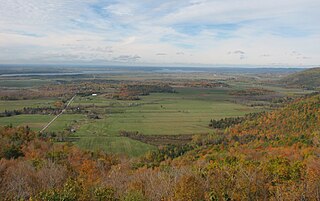
The Ottawa Valley is the valley of the Ottawa River, along the boundary between Eastern Ontario and the Outaouais, Quebec, Canada. The valley is the transition between the Saint Lawrence Lowlands and the Canadian Shield. Because of the surrounding shield, the valley is narrow at its western end and then becomes increasingly wide as it progresses eastward. The underlying geophysical structure is the Ottawa-Bonnechere Graben. Approximately 1.3 million people reside in the valley, around 80% of whom reside in Ottawa. The total area of the Ottawa Valley is 2.4 million ha. The National Capital Region area has just over 1.4 million inhabitants in both provinces.

Aylmer is a former city in Quebec, Canada. It is located on the north shore of the Ottawa River and along Route 148. In January 2002, it amalgamated into the city of Gatineau, which is part of Canada's National Capital Region. Aylmer's population in 2011 was 55,113. It is named after Lord Aylmer, who was a governor general of British North America and a lieutenant governor of Lower Canada from 1830 to 1835.
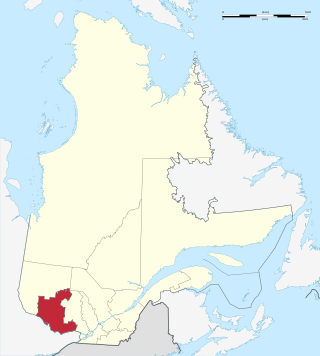
Outaouais is a region of western Quebec, Canada. It includes the city of Gatineau, the municipality of Val-des-Monts, the municipality of Cantley and the Papineau region. Geographically, it is located on the north side of the Ottawa River opposite Canada's capital, Ottawa. It has a land area of 30,467 square kilometres (11,763 sq mi) and its population was 404 265 inhabitants as of 2021.

The Senate of Canada Building is a government building and former railway station that serves as the temporary seat of the Senate of Canada. Located at 2 Rideau Street in downtown Ottawa, it was known as Ottawa Union Station and served as the city's central railway station from 1912 until 1966. From 1966 to 2018, it was operated by the Government of Canada as the Government Conference Centre. The building currently includes a temporary Senate chamber, as well as some Senate offices and committee rooms.

The Hull–Chelsea–Wakefield Railway was a 33 km (20.5 mi) heritage railway in Quebec, Canada, running tourist trains through the scenic Gatineau Hills and beside the Gatineau River between Hull and the tourist town of Wakefield from May to October, using a 1907 Swedish steam locomotive, E2 class number 909, and 1940s-built Swedish passenger cars. On average, the railway attracted about 50 000 tourists and generated revenues of about $8 million for the region.
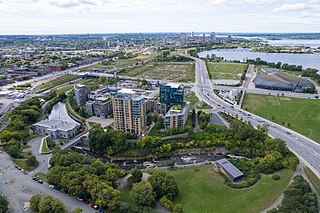
LeBreton Flats known colloquially as The Flats is a neighbourhood in Somerset Ward in central Ottawa, Ontario, Canada. It lies to the west of Centretown neighbourhood, and to the north of Centretown West. The Ottawa River forms the western and northern limit, with the western side being a wider area of the river known as Nepean Bay.

The Bytown Museum is a museum in Ottawa located in the Colonel By Valley at the Ottawa Locks of the Rideau Canal at the Ottawa River, just below Parliament Hill. Housed in the Commissariat Building, Ottawa's oldest remaining stone building, the museum provides a comprehensive overview of the origins of Bytown and its development and growth into the present city of Ottawa.

Huntingdon railway station serves the town of Huntingdon in Cambridgeshire, England. It is on the East Coast Main Line, 58 miles 70 chains from London King's Cross, and has three platforms: one bay and two through platforms. The station is managed by Great Northern, although most services are operated by Thameslink. During engineering works or periods of disruption London North Eastern Railway services sometimes call at Huntingdon, but there is no regular London North Eastern Railway service from the station.

The Tea Fire, also known as the Montecito Tea Fire, was a wildfire that began on November 13, 2008, destroying 210 homes in the cities of Montecito and Santa Barbara, California, in the United States of America. It was the first of several November 2008 wildfires that burned hundreds of homes from November 13–15, 2008. The Tea Fire ignited in the Cold Springs section of Montecito at approximately 17:50 PST on November 13, 2008. The fire started at a Mar Y Cel historic structure called the "Tea House" above Mountain Drive, giving the fire its name. Spreading rapidly, it was fanned by offshore winds, known as Sundowner winds, that blow down the Santa Ynez Mountains, gusting up to 85 mph (137 km/h). These winds caused the fire to spread into the city of Santa Barbara. The fire was 40% contained on the 15th, 75% on the 16th, and by November 17, 2008, it was 95% contained after burning 1,940 acres, and on November 18, it was 100% contained.
Ferdinand-Ambroise Gendron was a lumber merchant and political figure in Quebec. He represented Ottawa electoral district in the Legislative Assembly of Quebec from 1904 to 1917 as a Liberal.

In July 1906, the city of Dundee was the site of a large fire caused by the ignition of a bonded warehouse. The fire, which burned for 12 hours, has been described as the most destructive fire in the history of Dundee. The fire was described by an eyewitness as sending "rivers of burning whisky" through the city.
The history of Ottawa, capital of Canada, was shaped by events such as the construction of the Rideau Canal, the lumber industry, the choice of Ottawa as the location of Canada's capital, as well as American and European influences and interactions. By 1914, Ottawa's population had surpassed 100,000 and today it is the capital of a G7 country whose metropolitan population exceeds one million.

The Ottawa River timber trade, also known as the Ottawa Valley timber trade or Ottawa River lumber trade, was the nineteenth century production of wood products by Canada on areas of the Ottawa River and the regions of the Ottawa Valley and western Quebec, destined for British and American markets. It was the major industry of the historical colonies of Upper Canada and Lower Canada and it created an entrepreneur known as a lumber baron. The trade in squared timber and later sawed lumber led to population growth and prosperity to communities in the Ottawa Valley, especially the city of Bytown. The product was chiefly red and white pine.The Ottawa River being conveniently located with access via the St. Lawrence River, was a valuable region due to its great pine forests surpassing any others nearby. The industry lasted until around 1900 as both markets and supplies decreased, it was then reoriented to the production of wood pulp which continued until the late 1990s and early 2000s.
Robert Conroy was an Irish-born business owner and politician in Quebec. He served as mayor of Aylmer from 1858 to 1860 and from 1866 to 1868. He was considered one of the most prosperous hotel operators and lumber barons in the Ottawa Valley during the 1850s.
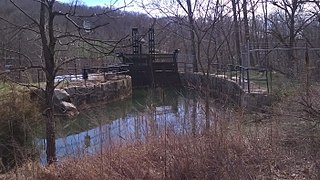
Avalon was a town in Rockingham County, North Carolina, in the United States. It was centered around a textiles mill constructed by Francis Henry Fries at the end of the 19th century. In 1911 the mill burnt down. Most of the population moved their homes to Mayodan, North Carolina and the area was left abandoned.

The bushfire season of the summer of 2017–18, was expected to have above normal bushfire risks with an elevated fire risk for the most of eastern and south Australian coastal areas. Australia had experienced its warmest winter on record and the ninth driest winter on record leaving dry fuel loads across much of southern Australia. Expected warmer weather over the summer period would also increase the risk. Bushfires were also expected to occur earlier, before the end of winter, as a result of the warm and dry winter. Both Queensland and north-eastern New South Wales experienced the wettest October since 1975 leading to a downgrade in bushfire risk.
